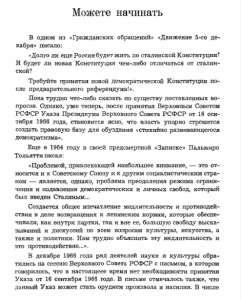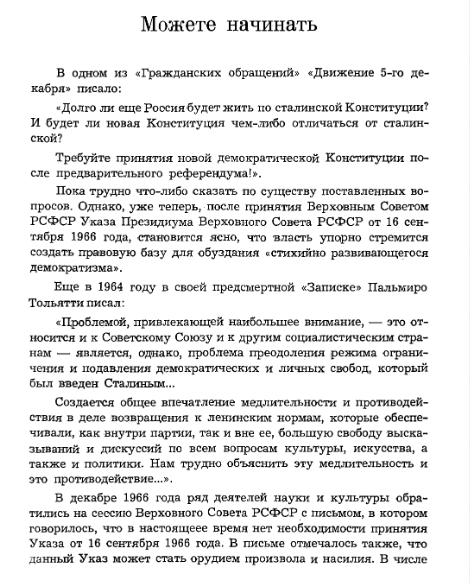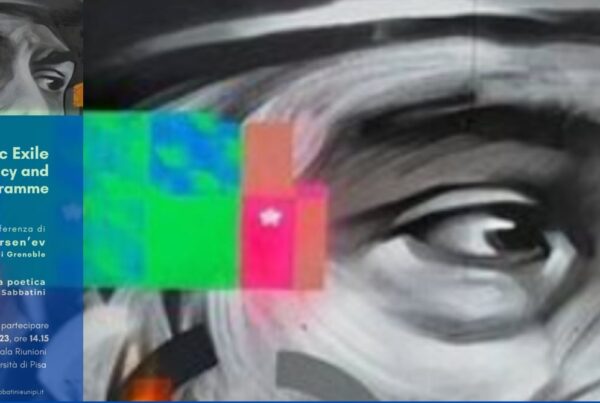
Excerpt from the editorial article “Mozhete nachinat'” (You can start), “Feniks 1966”.
Title:
“Feniks 1966” [Phoenix 1966]
Period: 1966
Place: Moscow
Editor: Iurii Galanskov
Main contributors: Aleksei Dobrovolskii, Vera Lashkova, Pëtr Rodzievskii and others
Total number of issues: 1
Description:
Iurii Galanskov began his fight against the Soviet regime in 1961 when he edited, with others, the sbornik Phoenix 1961, after which he was arrested for spreading anti-Soviet material and confined to a psychiatric hospital. The backdrop for this first non-authorized editorial activity was Maiakosvkii Square, named after the Futurist artist, which had become a gathering place for muscovite youth (cf. Parisi 2013: 248).
Galanskov was a regular presence in the square: his poem-manifesto in Phoenix 1961, was read by many as unofficial praise of the Maiakovskii Square gatherings (cf. ibid: 257).
The poem, written to be performed aloud, is a fundamental element in the poet’s journey to self-definition. He sees himself as a sacrificial victim, who gives his life in the name of a future universal resurrection (cf. ibid: 258). That rebirth was an important concept for Galanskov, is shown by the title “Phoenix”.
After his arrest and internment, Galanskov returned to his activity as a “podpol’nyi literator” (underground literary figure). In his own words: “one who writes secretly, as a loyal citizen of his country and a man of honor, [who] cannot let scorn for his country and her children go unnoticed” (Galanskov 1968: 85).
With this conviction, he set out to write a pacifist magazine; however, after Siniavskii and Daniėl’s arrest, in 1965, he was forced to change his plans and began to campaign for the rights of his detained colleagues, asking for the observance of the Constitution and Soviet laws.
In support of the two writers, the “glasnost meeting ” was organised by the mathematician Aleskandr Esenin-Volpin, in Pushkin Square, a protest attended by nearly seventy people, including Galanskov (cf. Clementi 2007: 50-53).
Unlike Phoenix 1961, “Phoenix 1966” covered a range of subjects with articles on literary criticism, philosophy, history, religion and politics. According to the “Grani” editorial office, the “Phoenix 1966” collection was considerably more political than other illegal magazines (cf. Redaktsiia 1967: 3-4).
Galanskov was well aware that the Soviet authorities would not approve of many of the essays and articles in “Phoenix 1966”. In the editorial article Mozhete nachinat’ (You can start), he states: “You could also win this battle, but you will lose the war. The war for democracy and for Russia” (Galanskov: 1968: 15).
The texts selected for the magazine are critical of the situation in the Soviet Union; one of the first essays to be included was Chto takoe sotsialisticheskii realizm (On Socialist realism) by Andreii Siniavskii. As well as editor, Galanskov was also the author of several poems and essays, including: Otkrytoe pis’mo Sholokhovu (Open letter to Sholokhov) and Organizatsionnye problemy dvizheniia za polnoe i vseobshchee razoruzhenie i mir vo vsem mire (Organization of the movement for total and general disarmament and peace in the world).
The poet did not limit his criticism to the Soviet Union with its dictatorial, bureaucratic systems and literary stagnation, he also sought to bring international problems such as disarmament to public attention.
His sense of honour and humanitarianism led him to voice disapproval both of the Soviet Union and of international politics; he took part, for example, in many sit-ins in the first half of the Sixties.
Shortly after “Phoenix 1966” was released, Galanskov was arrested and tried in the famous “Protsess Chetirëkh” (Trial of the Four), which also involved Aleksander Ginzburg, Alksei Dobrovolskii and Vera Lashokova.
The four were accused of spreading anti-Soviet information and in addition Galanskov was accused of having contacts with the Narodnyi Trudovoi Soiuz (Labour Union), based in Belgrade (cf. Clementi 2007: 77).
Galanskov was convicted under article 70 to seven years in a forced labour camp in Mordovia, where he died in 1972 due to complications following unsuccessful surgery (cf. Parisi: 2013: 257).
“Phoenix 1966″can be considered an example of glasnost’ for two reasons: first, because Galanskov’s name and address were explicitly written on the magazine, a tactic already used by Alik Ginzburg in the almanac Sintaksis (cf. ibid: 195).
Second, because the collection is composed of texts that explicitly criticize the Soviet situation, identifying those deemed guilty and making clear the need to re-establish constitutional liberties.
Diletta Bacci
[30th June 2021]
Bibliography
- Bacci D., Gli inakomysljaščie e la loro eco in Italia: la pubblicazione della rivista non ufficiale Feniks ‘66, BA Thesis, Course of Languages, Literatures and Intercultural Studies, University of Florence, a.y. 2017-2018.
- Clementi M., Storia del dissenso sovietico (1953-1991), Odradek, Roma 2007: 71-95.
- Galanskov Iu., Feniks ‘66: rivista sovietica non ufficiale, Jaca book, Milano 1968.
- Galanskov Iu., Sbornik. Samizdat, “Grani”, 89-90 (1973): 143-203.
- Osipov V., Ploshchad’ Maiakovskogo stat’ia 70-aia, “Grani”, 80 (1971): 107-140.
- Parisi V., Il lettore eccedente. Edizioni periodiche del samizdat sovietico, 1956-1990, il Mulino, Bologna 2013: 247-262.
- Redaktsiia, Feniks 1966, “Grani”, 63 (1967): 3-8.
To cite this article:
Diletta Bacci, Phoenix 1966, in Voci libere in URSS. Letteratura, pensiero, arti indipendenti in Unione Sovietica e gli echi in Occidente (1953-1991), a cura di C. Pieralli, M. Sabbatini, Firenze University Press, Firenze 2021-, <vocilibereurss.fupress.net>.
eISBN 978-88-5518-463-2
© 2021 Author(s)
Content license: CC BY 4.0





